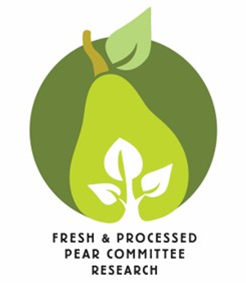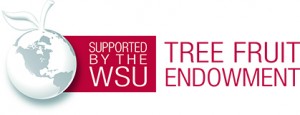Written by Paige Beuhler, Tory Schmidt, and Ines Hanrahan, Washington Tree Fruit Commission, April 2025
Based on the recommendations of the Pear Research Subcommittee (PRSC), the Fresh and Processed Pear Committees (FPC & PPC) approved $298,045 to fund five new pear research projects in 2025.
2025 New Pear Project Details:
Project Title: Can Scouting and Thresholds Increase Pear IPM Adoption and Improve Fruit Quality
Organization(s): Washington State University
Principal Investigator(s): DuPont, T.
Total Funding Amount for All Years: $78,599
Length: 3 Years
Researchers and growers have developed a biologically based pear IPM toolbox aimed at producing high-quality fruit while reducing costs. This toolbox includes methods to conserve natural enemies, economic thresholds for insecticide use, and pest development-based spray timing. To support IPM adoption, a Scouting Network was introduced to provide detailed natural enemy data, especially important during the transition period when biological control is still stabilizing. Current field staff cannot dedicate the necessary time for this level of scouting, so the network helps fill that gap using standardized methods.
Piloted in 2023 and expanded in 2024, the Scouting Network provides weekly pest and natural enemy data to growers and consultants. In 2023, 34 orchards were scouted, benefiting 12 growers and 8 consultants. In 2024, 87 blocks totaling 914 acres were monitored. Early results show that scouting helped reduce unnecessary sprays, improved pest control timing, and boosted natural enemy populations. Participants reported better fruit quality and greater IPM adoption. To continue, the network must prove cost-effective. Plans for 2025–2026 include expanding to 1,500 acres annually with USDA and industry support. The project will evaluate the impact of scouting on spray practices, fruit quality, costs, and help refine IPM programs using real-world data.
Objectives:
- Assess Scouting Impacts on Operations: Survey 40 participants to evaluate how scouting influences pest management practices, costs, and fruit quality across 1,500 acres.
- Measure Fruit Quality Outcomes: Inspect fruit from 50 orchards near harvest to compare quality grades against standard targets for psylla damage.
- Analyze Spray Cost Reductions: Compare spray records from 25 blocks with historical data to determine changes in application frequency, material use, and expenses.
- Refine IPM Programs: Use scouting data to test updates to IPM strategies, such as evaluating the effect of pre-bloom broad-spectrum sprays on pest control outcomes.
Project Title: UV for Postharvest Decay Control in Storage and on Packing Line
Organization(s): Oregon State University, Washington State University
Principal Investigator(s): Wang, Q., Waite-Cusic, J., KC, A., Murphy, C.
Total Funding Amount for All Years: $178,532
Length: 3 Years
Postharvest decay in pears leads to major economic losses, primarily caused by fungal pathogens such as Penicillium expansum, Botrytis cinerea, and Mucor piriformis. These pathogens are present on fruit surfaces at harvest and spread during handling, storage, and packing through airborne spores and contaminated equipment or surfaces. Repeated use of fungicides has led to resistant strains, while organic producers face even fewer effective options, highlighting the need for improved sanitation and alternative decay control methods. UV-C light offers a promising non-chemical approach to postharvest sanitation. It effectively inactivates microbes by damaging their DNA and is widely used for water, air, and surface disinfection. UV-C leaves no chemical residue, poses minimal safety risks, and is compatible with organic production. It has already been shown to control postharvest decay in various fruits and vegetables, including apples, berries, and citrus. However, its effectiveness can be limited by poor surface penetration and uneven exposure on irregular fruit surfaces.
To address these challenges, this project aims to optimize and evaluate UV-C technology for controlling pear decay in cold storage and packing line settings. In cold storage, UV-C will be tested on surfaces like bins, metal, and pears to reduce spore contamination and cross-contamination risks. On packing lines, UV-C will be used alongside low-dose antimicrobial sprays to improve coverage and efficacy. Research efforts include lab-scale testing, optimization of UV-C systems, shelf-life and quality analysis, and pilot-scale validation. The work will focus on maximizing UV-C effectiveness while minimizing resource use. This research supports industry goals by reducing postharvest losses, extending storage life, and improving fruit quality through novel, sustainable decay management practices.
Objectives:
- Test UV-C’s ability to sanitize pears and cold storage surfaces and reduce cross-contamination.
- Evaluate UV-C’s use on packing lines, alone or with mild antimicrobial sprays, and assess fruit quality.
- Validate optimized treatments in bulk cold storage and on pilot packing lines.
Project Title: Pear Rootstock Breeding
Organization(s): Washington State University
Principal Investigator(s): Evans, K.
Total Funding Amount for All Years: $320,215
Length: 3 Years
A major challenge for high-density pear orchard systems in the Pacific Northwest is the lack of cold-hardy, size-controlling rootstocks with early fruiting (precocity). To address this, a pear rootstock breeding program began in 2016, producing the first segregating seedling populations. These populations have been evaluated in successive projects, and 40 promising rootstock selections that are now ready for further testing.
This project focuses on advancing these selections through additional screening and establishing a replicated trial to gather data on tree vigor, yield, and fruit quality—critical traits for identifying top-performing rootstocks. Continued evaluation of younger seedlings will also prioritize vigor and early production. The project aims to strengthen existing collaborations with USDA-ARS and expand genomic research to better identify genetic regions linked to important rootstock traits. As the program moves into this second evaluation phase, costs will increase, but the budget will be managed by limiting objectives beyond core breeding efforts and covering additional expenses through royalty income. The overarching goal remains the development of dwarfing rootstocks suited for modern, high-density pear orchards.
Objectives:
- Develop and evaluate new seedling populations for rootstock potential.
- Establish a Phase 2 replicated orchard trial for selected rootstocks.
- Expand genomics collaborations to identify key genetic traits.
Project Title: Detection and Management of Mucor Rot in Pear
Organization(s): Washington State University
Principal Investigator(s): Amiri, A.
Total Funding Amount for All Years: $98,537
Length: 3 Years
Severe frost damage in central Washington during 2024 led to widespread declines in fruit quality, leaving many pear orchards unharvested. As a result, fruit left on trees or fallen to the ground will likely mummify and may become a significant source of pathogen inoculum for the 2025 growing season, potentially affecting fruit quality into the 2025–26 storage period. Growers facing unharvested orchards will need to adopt new management strategies in 2025 to mitigate this risk.
Among pear diseases, Mucor rot is particularly problematic due to its resistance to all three currently available postharvest fungicides. Unlike most pome fruit pathogens, Mucor is a zygomycete, which limits the effectiveness of conventional treatments. Surveys in Washington and northern Oregon revealed Mucor rot contributed up to 15% of postharvest decay, with some lots reaching as high as 65% incidence. Recent lab tests have shown promise with alternative chemistries, though further screening is needed to determine their practical application as fungicides or sanitizers. This three-year project aims to improve the understanding and management of Mucor rot through risk assessment, detection tools, and new treatment options.
Objectives:
- Assess inoculum levels of major pathogens at winter’s end and early spring to guide 2025 disease management.
- Develop a rapid detection assay for Mucor in soil, bins, and flume water using a portable LAMP test to evaluate storage risk within 30 minutes.
- Test novel chemistries for efficacy against Mucor rot both in laboratory conditions and on pears, exploring their use as fungicides or sanitizers.
Project Title: Finding Mucor Rot Management Solutions
Organization(s): Oregon State University
Principal Investigator(s): Pearson, B.
Total Funding Amount for All Years: $70,605
Length: 1 Year
Mucor piriformis, the pathogen responsible for Mucor rot, causes significant postharvest losses in pears, with some industry reports citing up to 40% losses in severe years. Traditional fungicides are largely ineffective, as this zygomycete class fungus is not controlled by standard treatments. Dump tank water in packinghouses is a key point of contamination, and although chlorine helps disinfect the water, it does not prevent infection through wounds.
Natamycin, a naturally derived, OMRI-approved compound (BioSpectra 100SC), has shown promise in lab trials, reducing Mucor rot by 50–65% on d’Anjou pears. However, real-world efficacy, optimal application methods, and compatibility with other postharvest chemistries remain unknown. There are also concerns about its chemical stability and interactions with sanitizers like bleach. This project seeks to evaluate natamycin’s practical use in commercial pear packing environments and identify best practices for its implementation.
Objectives:
- Determine if natamycin (BioSpectra 100SC) is compatible with other postharvest fungicides.
- Evaluate whether BioSpectra 100SC works better alone or in combination with other postharvest fungicides for reducing losses from Mucor rot.
- Evaluate the effects of BioSpectra 100SC applied to inoculated pears on a commercial packing line.
- Determine optimal methods for applying BioSpectra 100SC to pears on commercial pear packing lines.
Contact:
Paige Beuhler, Administrative Officer
paigeb@treefruitresearch.com
509 665 8271 ext. 2
Fruit Matters articles may only be republished with prior author permission © Washington State University. Reprint articles with permission must include: Originally published by Washington State Tree Fruit Extension, Fruit Matters at treefruit.wsu.edu, and a link to the original article.


